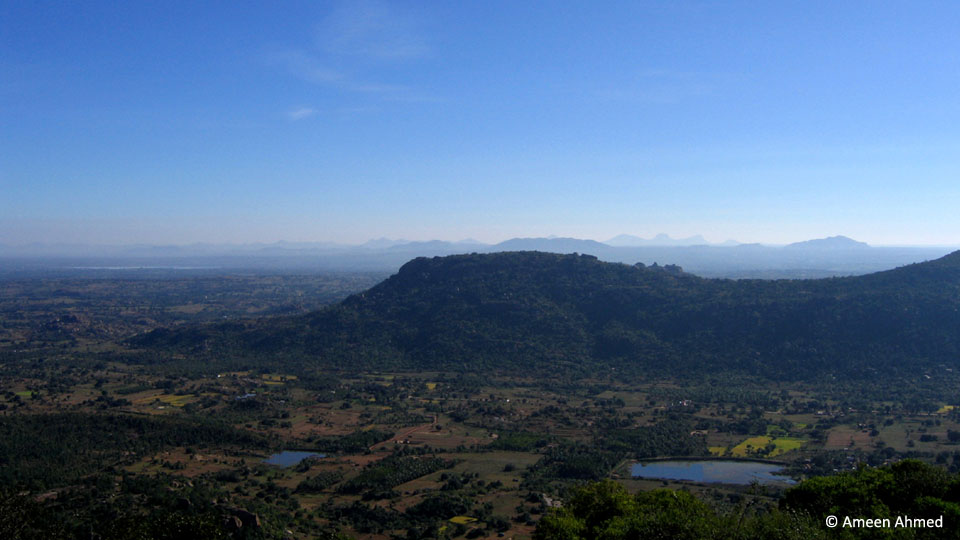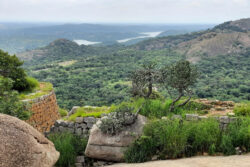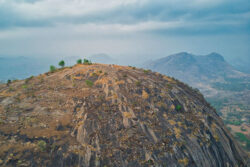We all have a wilderness area which we hold close to our heart – an area that, for the first time, helped us fall in love with the open skies, the closed canopies, the tall hills, the grassy plains, clear water springs, as well as the sights of fleeing deer and the calls of insects and birds. In my case, as might be the case with you, it happened to be a wilderness which was close to my childhood home.
I grew up in Tumakuru town, a proverbial stone’s throw distance from Devarayanadurga hills. People living near the Western Ghats or the Himalayan foothills are lucky to have dense forest patches, many of which are contiguous with big national parks and wildlife sanctuaries, as their hinterland playgrounds. On the other hand, young people in the maidan region (eastern plains) of Karnataka have vast open plains, expansive and picturesque wetlands, as well as isolated, broken rocky hill chains to help them fall in love with nature. The small cluster of hills of Devarayanadurga are a part of the longer Closepet Hill Range which rises from the plains of Karnataka’s Deccan Plateau, some monoliths amongst it shooting up over a thousand metres from their surroundings, forming a spectacle of immense scenic richness. Made up of metamorphic rocks, they appear at Hospet near Bellary and run roughly for about 300 kms in a southwardly direction till Yelandur near Chamrajanagar. Amongst their well-watered valleys are patches of dry and moist deciduous forests that harbour many species found in Eastern and Western Ghats, hundreds of kilometres away. Realising the importance of these woods as sources of water and also fuel-wood in some cases, the British initiated their protection from as early as the 1850s. Many of the woods were later given the status of reserve and state forests; the Devarayanadurga State Forest that surrounds the hill and village by the same name is one such forest.
 The forested valleys and rocky hills of Devarayanadurga
The forested valleys and rocky hills of Devarayanadurga

Located inside the Devarayanadurga state forest, the popular picnic spot Namada Chelume was, in those days, more popular than Devarayanadurga hill itself. This because of the fact that public transport was very sparse and hardly a few people could afford a two wheeler – let alone a car – to drive up the steep hill, unlike today. In fact, Devarayanadurga forest was referred to as ‘Namada Chelume ka jungle’ in colloquial Deccani Urdu, my mother tongue. Namada Chelume is a perennial spring which many day-time picnickers would visit then, often to prepare and eat food. The food would be prepared in the abandoned British forest bungalow, a place where Salim Ali had probably stayed during his visit to Devarayanadurga on New Year’s Eve of 1940. This was during his study of the erstwhile state of Mysore, which was facilitated by the Maharaja of Mysore.
 Hills of Bengaluru, Kolar and Chikballapur districts, as seen from Devarayanadurga on a clear morning
Hills of Bengaluru, Kolar and Chikballapur districts, as seen from Devarayanadurga on a clear morning A view of the vegetation at Namada Chelume, in the year 2000
A view of the vegetation at Namada Chelume, in the year 2000‘Jhaad bandar’ (Urdu) or ‘Mara koti’ (Kannada) was a popular outdoor game that kids of those days played during their visit to either a garden or a jungle. A group of kids would sit atop tree branches, with one of them trying to catch a ‘monkey’ that would get off one tree and try to climb up another for the thrill of being chased. The one caught would then have to play the chaser while the rest would stay up the trees, getting down only to climb another tree. We had our share of playing this game that day, as the elders were involved in cooking a sumptuous biriyani using fuel-wood from the forest.
More serious visits to these jungles
My occasional journeys to this jungle with the family continued until I entered high school in the mid-80s. The Bharat Scouts and Guides movement, of which my high school was a part of, encouraged us to indulge in outdoor adventures. We would take off to this jungle on our bicycles. In the late 80s, I associated myself with the Wildlife Aware Nature Club (WANC) at Tumkur, where I met serious nature-lovers under the leadership of T.V.N Murthy, its founder; all were keen to explore the wildernesses around. From then on, as a part of this group, I started documenting the forests through my pen, and a couple of years later, through a film SLR camera which a visiting uncle from the USA gifted us siblings. I participated as a resource person for many nature camps held in this forest by WANC as well as the Karnataka Forest Department. During this journey, WANC and its members were supported with knowledge by many naturalists and nature lovers, particularly from the Merlin Nature Club, Bengaluru. Some names I can recollect are S.Karthikeyan, J.N.Prasad, S.Subramanya, U.Harish Kumar, T.A.Srinivasa as well as late M.K.Srinath. And we always had officials from the forest department, from forest watchers to the Deputy Conservators of Forests, who would help us in our environment education efforts with smiles on their faces.
 A nature camp organised by the Forest Department with resource persons from WANC, in 2000, at Namada Chelume
A nature camp organised by the Forest Department with resource persons from WANC, in 2000, at Namada Chelume
 The lonely Shivagange Hill, seen from Devarayanadurga hills
The lonely Shivagange Hill, seen from Devarayanadurga hillsWildlife lovers these days tend to focus more on existing parks and sanctuaries for their recreational needs like birdwatching and photography. I believe, apart from conserving existing sanctuaries, it is imperative that we also focus on lesser known wildlife areas (LWAs). Not only are our LWAs host to many water resources, they also hold the potential to develop into excellent wildlife areas with basic protection measures. The way Daroji Bear Sanctuary near Hosapete in Bellary District has developed is an example of this. There are many such places and many such examples of LWAs.
 Shadows in the Devarayanadurga jungle
Shadows in the Devarayanadurga jungleHere are some points I make in favour of conserving LWAs
1. LWAs not only hold the potential as breeding centers for wildlife, but can also mushroom into important areas for wildlife information dissipation for young people and a source of income for the locals around them.
2. Attention by the media can have the government focus on our beautiful but lesser known reserve forests as well as the entire landscape.
3. LWAs can take away the immense pressure of eco-tourism off our Protected Area (PA) network.
 A view of the Nandi Hill Range, another LWA, as seen from Devarayanadurga hills.
A view of the Nandi Hill Range, another LWA, as seen from Devarayanadurga hills.





Instagram
junglelodgesjlr